ALLIGATOR
BEHAVIOR page 5h: BABY
ALLIGATORS --page 8 Alligator
nests and babies page 1 2 3 4 5 6 7 9 10 11 12
This
page
was born 09/30/2021. Rickubis designed
it. Last
update: 10/06/2022
Images
and
contents on this page copyright ©2022 Richard M. Dashnau
2021
Proved to be an good year to watch nests. So, here's a new page
showing
what I saw. Since there was direct progression between
observations,
I'm starting with the oldest
at
the top of the page so that events are easier to follow.
04/18/2021 Volunteered
at BBSP this morning. I had signed up to work in the Nature Center,
but
I had a few hours to walk some trails before my shift. I've
seen
3 different pods
of
baby
alligators(with their mother) so far this
Spring. This morning I was able to catch this gator mom
(sometimes they aren't out when I'm around), and she even had a baby
on her back!
Another baby climbed aboard while I was talking to
visitors. These aren't the greatest images, since there are lots of
twigs and/or in the shots--but there isn't much
I can
do about that.
I suspect that those growths are part of the reason she is
relatively
passive while people are on the trail nearby. I believe that
the
cover that those growths
provide--sparse
as it is--still offer
her
some sense of security. So, here she is. In the
last image,
she'd moved into deeper water, and the babies were sliding off of
her.



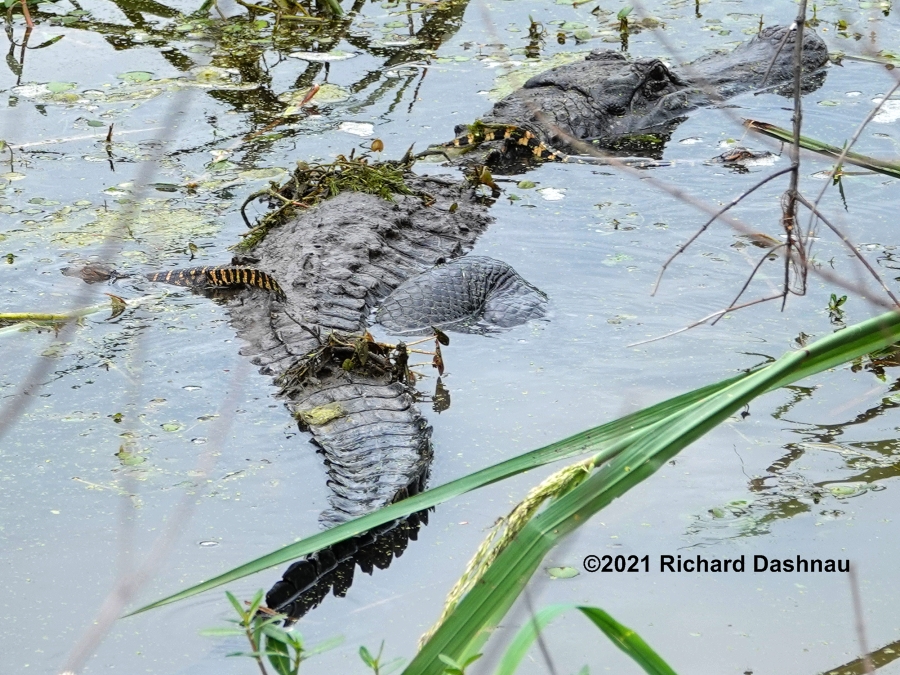
04/04/2021 Back
to
Brazos Bend State Park! It was great to be out on the trail and
interpreting Nature for interested visitors. It was Easter Sunday,
which is usually one of our busiest days,
so I was on my bicycle.
While this lets me cover more trails, it cuts down on what I
can
see. However, that doesn't mean I missed everything.
I
found this alligator with her babies in 40
Acre Lake (first two pictures below).
A few hours later,
she had moved a bit, and some of her babies were on her, and also
foraging
in the water around her. While I was talking with visitors,
we
watched a Little Blue Heron (Egretta caerulea) enter the scene. I
figured that even the smallest baby alligators would be larger
prey than this Heron would eat. In the picture below right,
one
of the babies is visible in the upper right corner. The
babies
seemed to be unconcerned about the heron--which moved off.




Below
are more images showing
how two of the babies moved over time on their mother's head. Behold
the cuteness!!
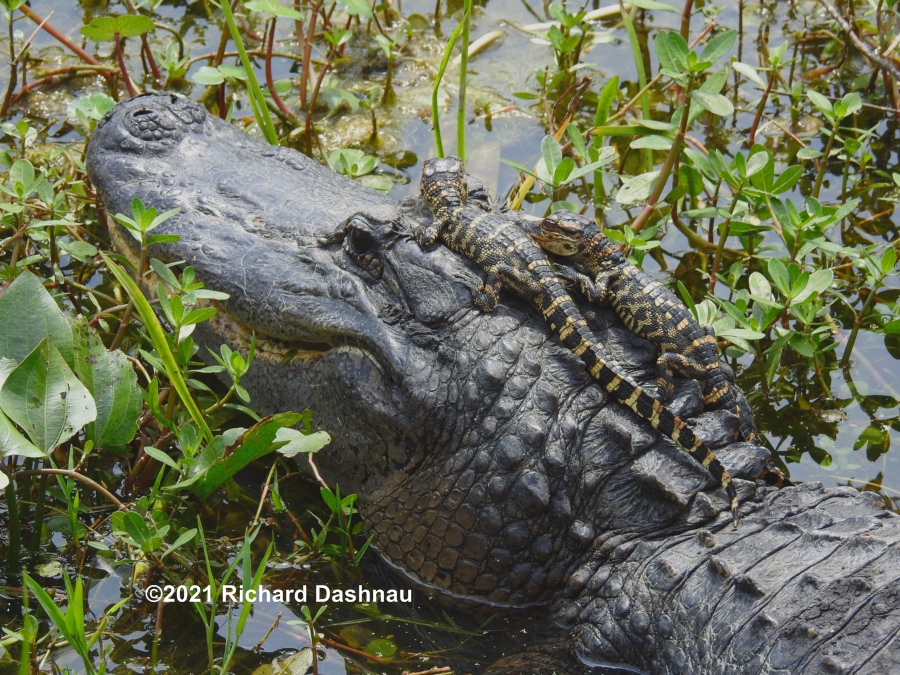



I'd spent the day cruising
the trails around and between 40 Acre Lake and Elm Lake. Between
the times I visited
40 Acre Lake I found another alligator mom with her babies on
one
of the small dirt banks-which act like tiny islands-in Pilant Lake
along the Spillway Trail. The first picture shows mother on the bank,
partially hidden by trees. The babies
are on the mud at the left.
The second picture is a zoomed closeup of the babies. The
third
picture shows the different perspective when I moved to my right a few
feet-there is
a baby on her back.. The last picture shows her
after she's turned around (with the baby still on her back).
This
mud bank is about 25 yards away from the trail.




The
smallest
babies in these pictures would be--at the youngest--about 6
months old. Many people (and I spoke with about 100 visitors
on
this day alone) were surprised about this.
A common impression is
that these babies are newly-hatched (maybe partly because of their
size, maybe partly because it's Spring). They
always nest
in June, and it takes about
60 days for the eggs to incubate-so that limits when the babies hatch.
So alligators
only hatch once per year, and always during the weeks that August
becomes September. Since
this
is near the beginning of Fall, the babies encounter cool to cold
weather as Winter approaches and passes. So, they don't eat (most if
not all of their food isn't active), and
therefore
do not grow at
all. It's only when Spring returns and the park awakens when
their food becomes active, and their metabolism allows them to catch
and eat it. By the end
of
their first full year (the next September
after they hatched) the babies have normally grown about 4 inches to
be
about a foot long. They try to stay by their mother for a few
years,
so sometimes babies of various sizes (maybe up to 2 feet long) are
near
her. Looking at those, one could guess their age by adding a
year
to the month we are in. Smallest babies
we
see today (April 6th) are
about 6 months--those that are few inches longer could be 18 months (a
year + 6 months) and so on. Most of the newest babies don't get to be
a
year old-
probably
due to predation, and mostly by wading birds like
herons, egrets, and bitterns (other people have pictures online of
baby
alligators being eaten by these at Brazos Bend State Park).
06/27/2021 (posted
07/03/21) I
had stopped to enjoy the sight and sound of the crowd of birds that
were nesting at the Northwest corner of 40 Acre Lake. Most of the nests
seemed
to contain Cattle Egrets, but there were other waders in
there, too. While I let the sound of the multitude surround me, a
lower, longer sound appeared. An alligator had started
bellowing!
It sounded like a female. After a few
minutes, other alligators started bellowing from further
away. At
that time, I couldn't see any, though at least one of them seemed to be
somewhere among
the trees inside the bird rookery. I moved East, and
I hadn't gone far when I heard bellowing again, but this time from one
of the islands in 40Acre lake. This one also sounded like a
female, and I found her!
She was in the water, and there was
an alligator nest up on the island behind her. She performed
3 or
4 bouts of bellowing, and I was able to film her as she did. I heard
other alligators in the chorus.
Some were behind me in Pilant
Lake, but a few were further East, in 40 Acre Lake.After it stopped
bellowing, I went to look for the other alligators I'd heard.
Here's another picture of the nest about three hours later.
Mom is in the water
in front of the nest, in the shade. I shot some
video, and that can
be
seen here. It's worth a view, if only to hear
the bellowing mixed with the bird calls.



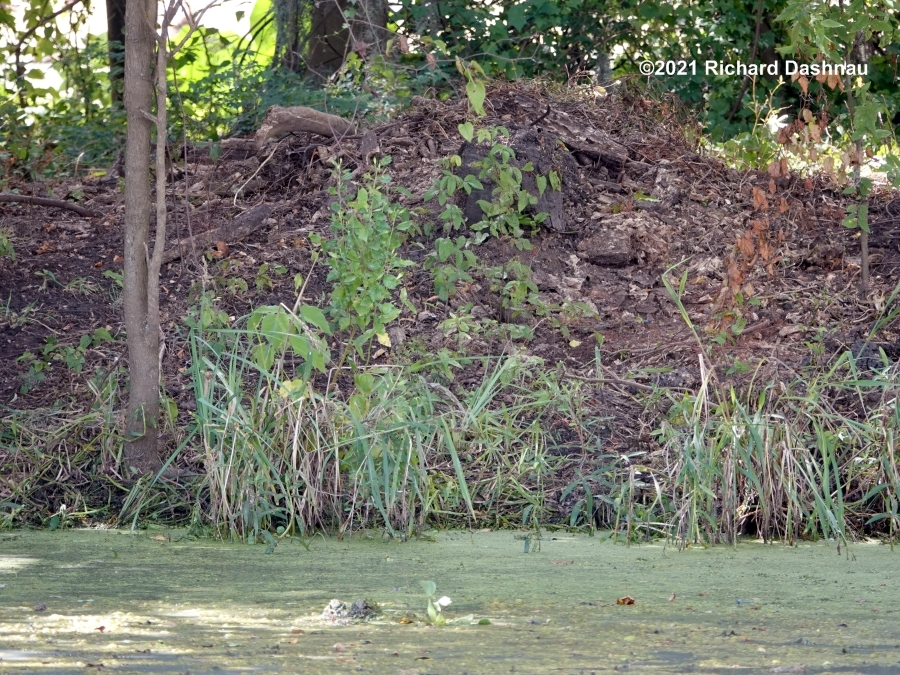
THE
WADING BIRD ROOKERY
BELLOWING
FEMALE AT THE ISLAND
NEST IS ON THE LEFT, MOM IS AT
RIGHT
SAME
NEST ABOUT 3 HOURS LATER (NOON)
I
had a close encounter with a Texas Rat Snake about 30 minutes after
this, but first-- About 10 minutes later, I found another alligator
near the islands, in front of another another nest!
This
nest was built at the base of a broken tree. This second nest was about
70 yards East of the first one I'd seen. The mother wasn't doing much,
so I moved on. About
30 minutes later, I was
near
the Observation Tower when I noticed another alligator bellowing near
East tip of the island. \Since
I was talking with park
visitors, I didn't try to shoot video, but I did get some
photos. This one also sounded like a female and, there was
another nest on the island behind her! I stayed near 40
Acre lake for the next couple hours, so I didn't find any other nests.
But I saw three!!!
Alligators' courtship/mating season is March - May;
and they normally nest in June. I'd been looking for nests
and was
happy to find these.



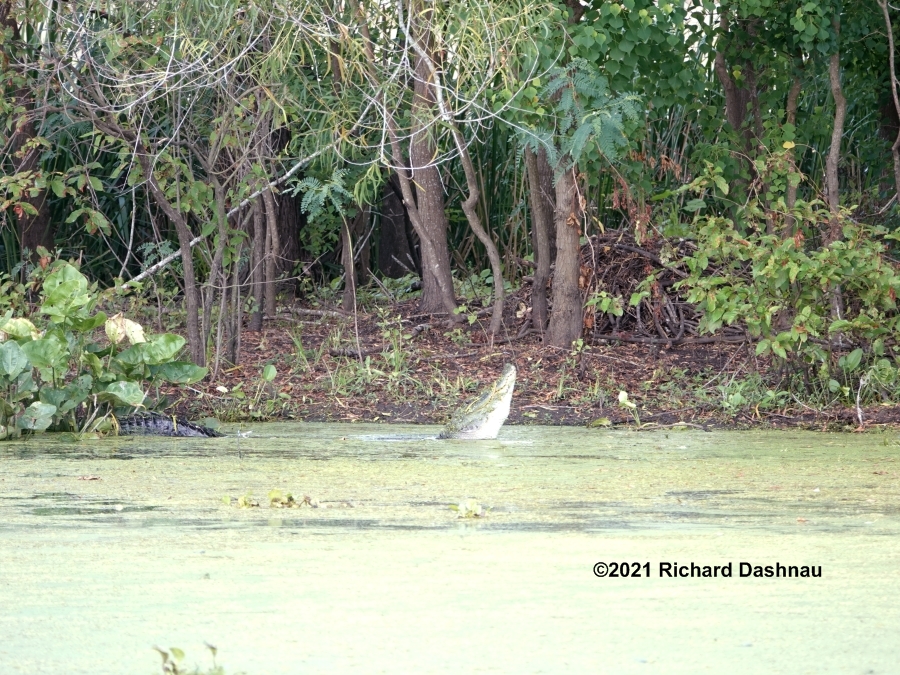
2ND NEST,NEAR TREE, MOM LOWER
RIGHT
A
FEW HOURS LATER, MOM IN THE
SHADE
BELLOWING
FEMALE AT THE ISLAND
NEST IS BEHIND
HER, TO THE RIGHT
07/04/2021
I
was back at BBSP a week
later, looking at the alligator nests on 40 Acre lake.
This time, I found an
additional nest, for a total of 4 nests between Hoots Hollow bench and
the Observation Tower.
I
also paced off distances between observation points. I know this is not
exact--each of my steps is about I meter long (I went with metric,
because otherwise each step is about 3 feet--and everyone knows I only
have
2 feet. :-) ). But it does give some idea of the spacing
between
the nests. I was also treated to a chorus of bellows (sounded like all
females to me) at about 9 am. No video this time, the wind wasn't right.
07/11/2021-update I was back at BBSP a week
later, looking at the alligator nests on 40 Acre lake.
During the week, I'd
thought about the measurements I'd recorded. There had been a
distance of 120/150 steps
between
nests in three examples, and a distance of 250 steps in one example.
So, the distance between those two nests was about twice the distance
of the others. Maybe there should be another nest in there. So
I'd
started looking for another nest between nests #2 and #3.
And....there was one! But it was NOT 120 steps
from nest
#2. This nest was 160
steps East of nest #2. And the next nest (previously #3 now
#4)
was
80 steps East of "new" nest #3 (this adds up to 240 steps instead of
250 I'd measured before...but close enough). There's a good
reason why the nest was NOT at the 120 step mark. The "new" nest is on
the
West end of one of the islands. That is, there's a gap
between two island very close to the 120-step mark--it's water!
So, I can now account for 5 nests on the islands in 40-Acre
lake.
I've corrected the images
below to agree with this new
information. So, that's a pretty regular spacing!
How
could the females know where the other nests were to avoid getting too
close to each other? It could be just random spacing,
but I
think that's not very likely. Well....not too long ago
(06/27/2021) I was in the middle of a chorus of female alligators at 40
Acre lake. In fact, that's how I found a couple of the nests.
(Referenced further down
this page.)Over the years I've been
observing alligators, I'd come to the conclusion that male gators
usually (not always) started a bellow chorus during mating season; but
after nesting, females usually started a chorus.
I haven't
found anything in "the literature" that specifically mentions this. But
I've always guessed that females might bellow to announce their nesting
sites. The regular spacing of the nests on these islands
might
be have been assisted by the bellowing of the females.
Other factors can (and probably do) influence nesting
locations.
Proximity to dens(if there are any), availability of dry land,
etc. could also factor in. I still
think it's an interesting overlap of events.
So,
starting from the bench
near Hoot's Hollow:
NEST #1 120 steps east of bench near Hoots Hollow.

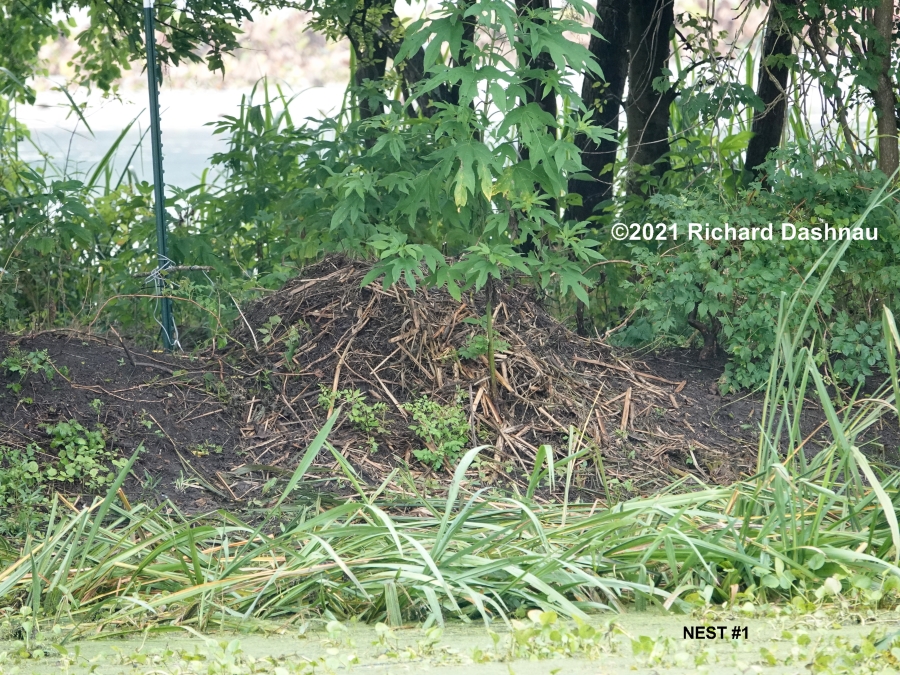
NEST #2
120 steps east of first nest (can see nest when standing next to the
tree).


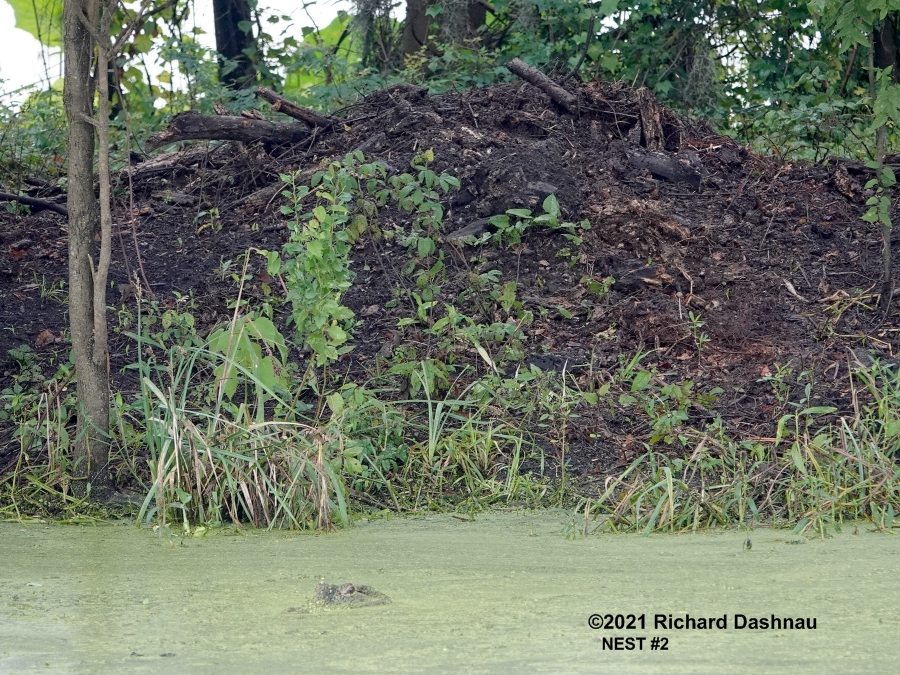
Here are some pictures from
07/11/21 showing mom on nest #2.



NEST #3
160 steps
east of 2nd nest (on West end of island).


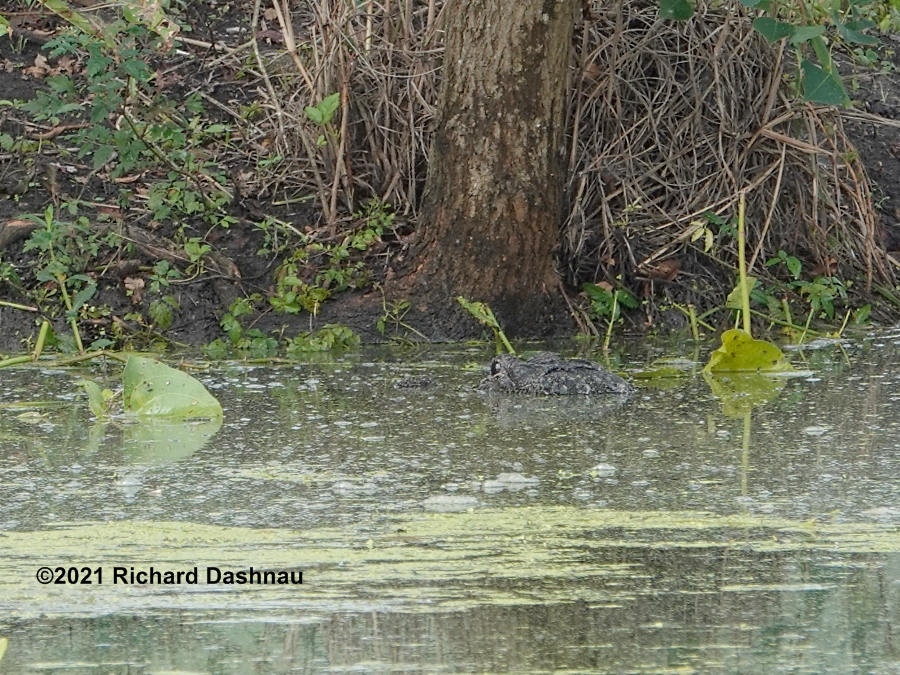
NEST
#4 80 steps
east of 3rd nest. (at base of broken tree on island).

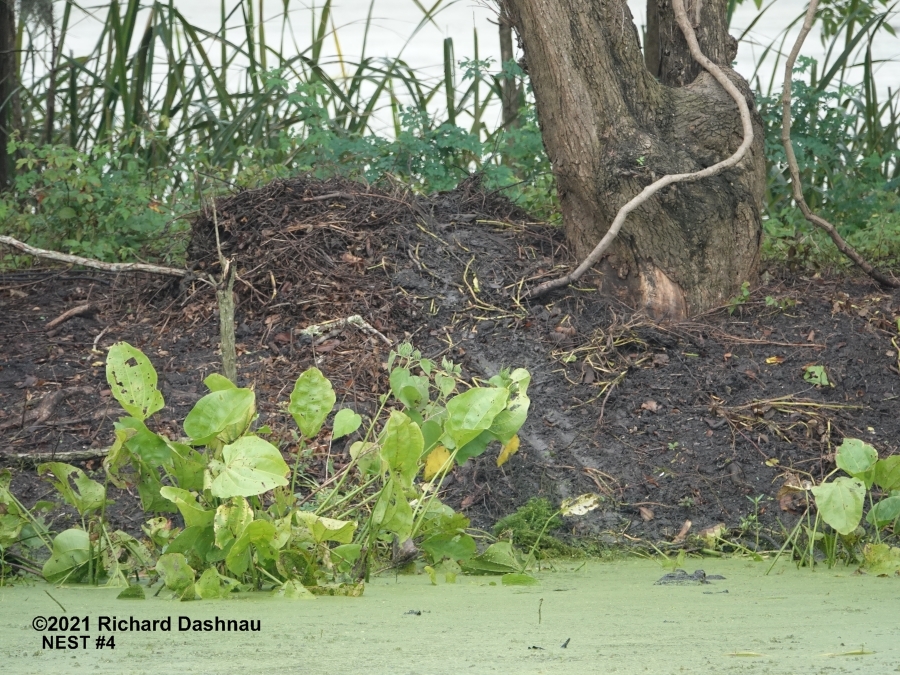
NEST #5 150 steps
east of 3rd nest. (East end of island, across from short footbridge by
the tower).


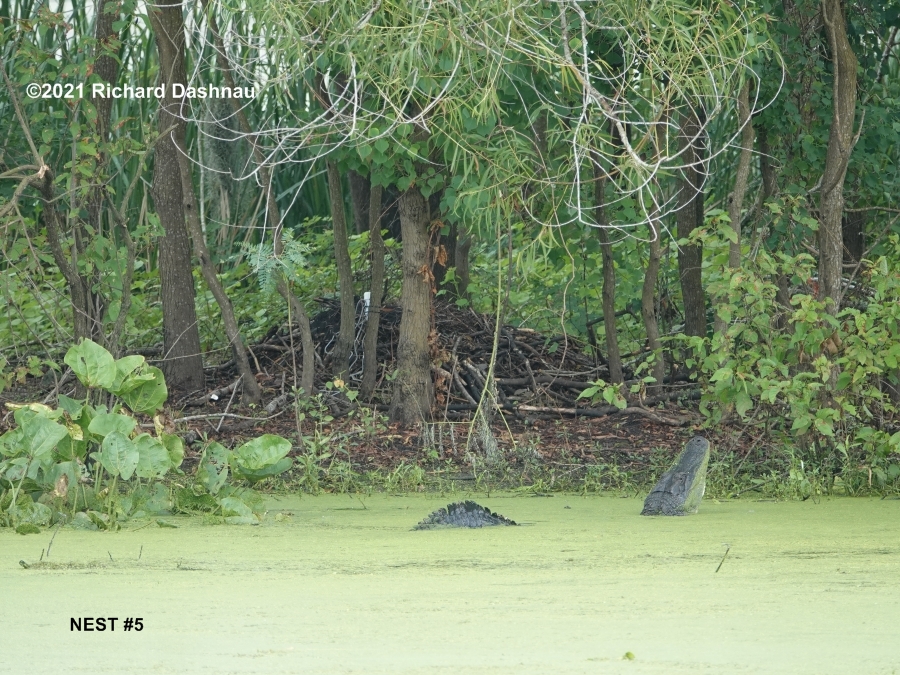
08/15/2021-
I
usually check on the 5 alligator nests that I know of in 40 Acre Lake.
They are the ones that I'd located and compared by pacing off locations
on
7/04 and 7/11. As far as I can tell, the nests are still
intact--not torn up by feral hogs, or anything else. I always
look for the mother gators near the nests, but
haven't had much
luck seeing them. But today, I could see the females near two
of
the nests; by my counting, nest #2 and nest #5. Alligator
eggs
should hatch after
about 2 more weeks (could be a bit before then,
or a bit after). Due to bright sunlight and large amounts of duckweed
mixed with algae on the surface, the alligators
are hard to see, but I took pictures anyway. So, here they are.



Nest #2 8/15/21 Mom is lower
left.
Nest #2
8/15/21 A bit
closer, see her? Nest #2 8/15/21 Closeup of
gator mom.


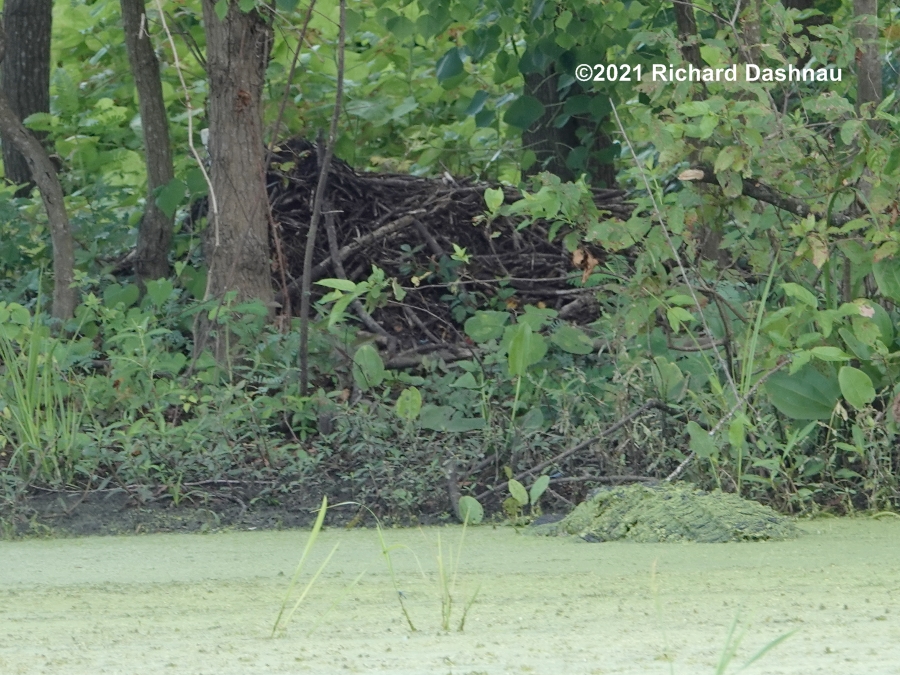
Nest #5 8/15/21 Mom is lower
right.
Nest #5 8/15/21 Mom has moved
up. Nest #25 8/15/21 Closeup mom
and nest.
09/05/2021
--
Just
about every day I spend at BBSP is pretty good, but some days are way
beyond good. On 9/5, I started at the 40 Acre Lake parking lot at about
8am.
Friendly folks were already gathering there for the scheduled
guided bird hike. I took to North path to the lake, going down the
hill. I mostly wanted to check the 5 alligator
nests that I
know-since it's time for gator eggs to hatch. Otherwise, I watch for
activity among all the birds, and whatever else is moving out there.
Nest
#1 looked intact. Nest #2 looked like it was opened, but I couldn't see
any babies, or the mother- even through binoculars. Nest #3
also
looked like it had been opened. Nest #4 looked intact.



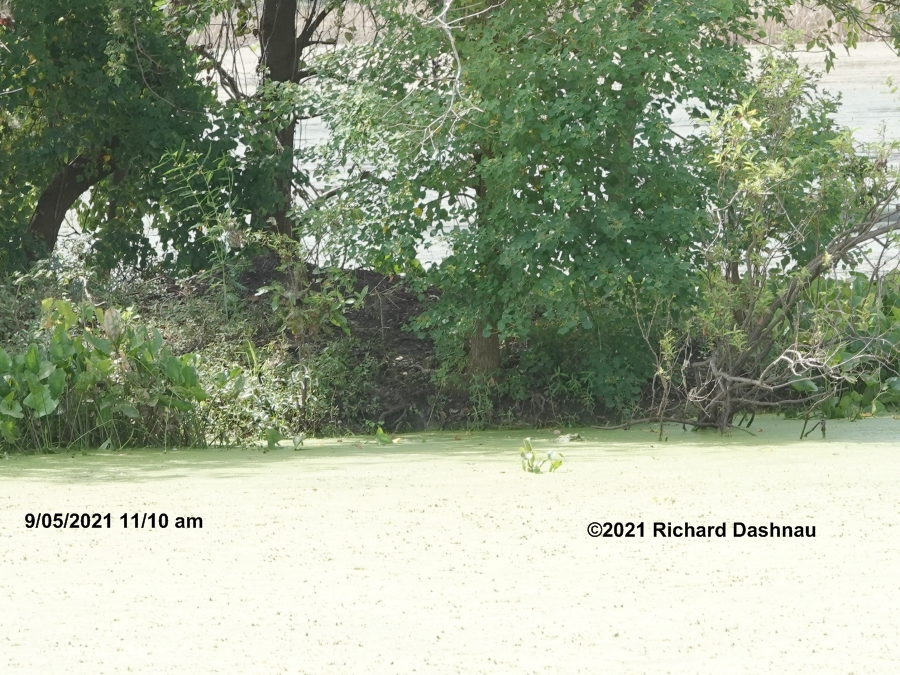
Nest #2 8/29/2021
closed
Nest #2 9/05/2021
opened
Nest #3 8/29/2021
closed
Nest
#3 8/29/2021
opened
I
continued to the Observation Tower, and checked on nest #5. That one
also looked like it had been opened. I'd already been watching the
nests, and nests 2, 3, and 5 had all had the "usual" rounded hump
shape.
Today, the humps were partially flattened--no longer rounded; a good
sign that the nests had been opened, either by the mother gator, or an
egg thief. Since I hadn't seen egg shells scattered around
any
of the nests (the islands are about 40 yards away), I thought the
chances were good that they'd hatched. I stayed by the
Observation Tower for a while, interpreting visitors that came by. A
large
alligator had appeared in the water in front of nest#5 at
about 8:40, and that just added to the number of subjects to talk
about.


Nest #2 8/29/2021
closed
Nest #2 9/05/2021
opened
On the way back, I
checked the
"opened" nests again. This time, I found an alligator near each one.
Alligators near nests #3 and #2 both faced the bank. Usually,
such attention is directed
at baby alligators near the nest. But I still couldn't find
any through the binoculars. I
spent about 2 hours on Live Oak Trail, scraping snail eggs (185
clusters) and I did get a brief look at a
raccoon as it quietly moved
through underbrush. Later,
I got a surprise when I looked through the pictures I'd
taken.
When I zoomed in on photos of nest #2, I found baby alligators there!
In the earlier pictures, they are covered by the algae, duckweed,
etc.,and
so are really well-hidden. In the later pictures, they are up on the
dirt, but just hard to see from 40 yards away.
They show up in the
cropped images below.



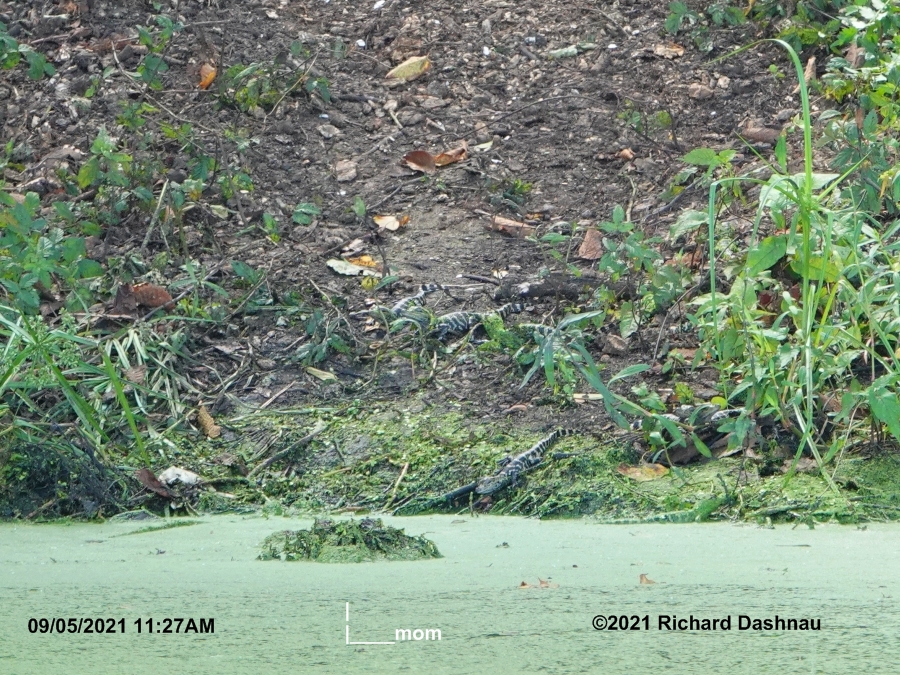
09/19/2021
--
On
the same day I saw the "Fancy Leech", I found a pod of baby alligators
on the
other side of 40 Acre Lake. The pod was near the trail, across from
Nest #2.
I was committed to some other activities, so I
couldn't stay near them for better pictures (I'd found them in the
morning.). So, here are a few pictures of the babies
and their mother. The first picture shows her location in
relation to the nest on the island.




Mom across from Nest #2
Mother
gator with babies.
Some
of the babies.
The same babies
cropped.

A few more of the babies.
On 10/03/2021;
this pod appeared on the trail, but on the Pilant Lake side. I'd
been
standing near this spot and talking to various visitors there
for a
couple hours. I'd even talked
about the new pods of hatchlings
that I was looking for, and how they normally appear on the
40Acre Lake
side (South side) of the trail. I left for a while, and saw them
on the
way
back-on the South side of the trail. I prefer to think that they
hadn't been there all the time, but had climbed up as the day
got
warmer. The babies eventually moved back into the
cover of the
plants shown in the pictures, and were well-hidden when they
did. There
was an adult alligator in the area, but at least 5 yards away
from this
pod, and it didn't seem to
be looking at the pod.




On
10/10/2021;
babies appeared on the trail, about 4 yards further East. Since
they
wre so close to where I'd seen them the week before, I
assume
that
it was the same pod.
I only saw a few babies, and didn't see an
adult alligator near. In a situation like this (the trail
was
bounded by water on both sides), it's possible that a pod could
be
divided.
That is, some of the babies could be on the North side of
the trail, and some could be on the South side--and their mother
could
be on either
side. Although I looked closely, I
didn't find any more babies, or their mother.



On
10/11/2021;
I found these babies babies at least 50 yards West of the other
pod.
They were in 40-Acre Lake (on South side) and were hard to find.
I had
seen some there on
previous
days, but couldn't get any pictures of them due to them hiding
among
the plants. They were across from "bird box" #21 (on the
island), and
next to a small Oak tree.
I stayed near these babies for a few
hours, trying to find more, and pointing them out to park
visitors.
While I was there, a Fox Squirrel was climbing up the Oak tree,
grabbing tiny
acorns, and then running off to one of three trees
that were some yards down the trail. It alternated storage
spots, and
on each return empty, and on each "delivery" trip; it paused on
the
trail and looked closely at us; as if waiting for us to go away.
When
we didn't, it ran past us (or me) (passing only about 3 yards
away) to
continue its job. There was an adult
alligator
in the vicinity, but at least 20 yards away, and it didn't
appear to be
watching the pod. Picture #4 below is a frame from the
video
I
shot of the squirrel so I could see what
it was carrying off. That's a tiny
acorn.




And,
this page shows
alligators at the park, on land, near various landmarks at the park.
Go back to my
main alligator page, Alligators
Go back to my home page, Welcome
to
rickubis.com
Go
back to the RICKUBISCAM
page.
Go
back to the See
the World
page.







































































